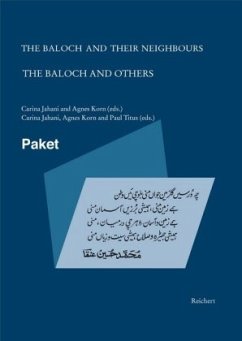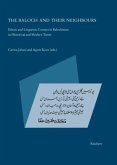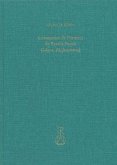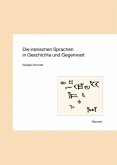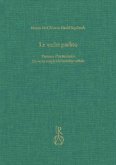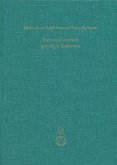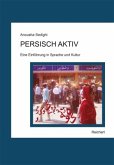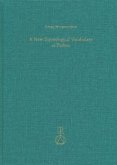Throughout history Balochistan has been an important contact zone between the Indian Subcontinent and the Iranian Plateau. Today Balochistan is a land divided among several states. It is a region where a variety of languages intermingle, different religions jostle for attention, and traditional ways of living are challenged by modernity. The papers in this volume explore Balochistan's linguistic, socio-political and cultural diversity. Some take a historical perspective, and others examine the dramatic developments now shaping the region.
Balochistan has been an important contact zone between the Indian Subcontinent and the Iranian Plateau. It is a region where a variety of languages intermingle, different religions jostle for attention, and traditional ways of living are challenged by modernity. The papers in this volume explore Balochistan's linguistic, socio-political and cultural diversity.
Balochistan is in many ways a marginalised region in Pakistan, Iran and Afghanistan. Traditional economies persist, but modernity is rapidly gaining ground. Tensions between traditionalism and modernity are explored in several articles. Other articles examine the impact of economic development in Balochistan.
Political borders are always problematic and this is particularly so in southwest Asia. Only in the late 19th century were the present borders between Iran, Afghanistan and Pakistan drawn. As modern nation states were consolidated in the 20th century, the Baloch found themselves under the dominion of Islamabad and Tehran. The Baloch nationalist movement, which is treated in a number of articles, has been much stronger in former British India-Pakistan than in Iran.
A powerful element of self-definition in the Middle East and South Asia is religious belief. In Balochistan this may take the form of Balochi Sunni assertions contra Persian Shia ones, or attempts by the minority Zikri Baloch to resist mainstream Sunnism. Another source of social demarcation is tribal affiliation. Thus difference between self and other is not always Baloch versus non-Baloch. Both religious and social demarcations are discussed in various articles in this volume.
The Balochi language is the subject of several articles in the volume. This language is a conglomerate of dialects with diverging grammatical systems, and it is therefore by no means possible to speak of a standard Balochi language. Throughout history the Baloch have been in contact with other groups, and this has influenced their language. In the eastern parts of the Balochi speaking-region contact with Indo-Aryan languages is particularly intense as it is in the western parts with Persian. But other languages are also spoken in Balochistan. This has created widespread multilingualism, where one language (the national language or an international language) may be used for reading and writing and Balochi as well as other local languages are used in various oral domains.
Hinweis: Dieser Artikel kann nur an eine deutsche Lieferadresse ausgeliefert werden.
Balochistan has been an important contact zone between the Indian Subcontinent and the Iranian Plateau. It is a region where a variety of languages intermingle, different religions jostle for attention, and traditional ways of living are challenged by modernity. The papers in this volume explore Balochistan's linguistic, socio-political and cultural diversity.
Balochistan is in many ways a marginalised region in Pakistan, Iran and Afghanistan. Traditional economies persist, but modernity is rapidly gaining ground. Tensions between traditionalism and modernity are explored in several articles. Other articles examine the impact of economic development in Balochistan.
Political borders are always problematic and this is particularly so in southwest Asia. Only in the late 19th century were the present borders between Iran, Afghanistan and Pakistan drawn. As modern nation states were consolidated in the 20th century, the Baloch found themselves under the dominion of Islamabad and Tehran. The Baloch nationalist movement, which is treated in a number of articles, has been much stronger in former British India-Pakistan than in Iran.
A powerful element of self-definition in the Middle East and South Asia is religious belief. In Balochistan this may take the form of Balochi Sunni assertions contra Persian Shia ones, or attempts by the minority Zikri Baloch to resist mainstream Sunnism. Another source of social demarcation is tribal affiliation. Thus difference between self and other is not always Baloch versus non-Baloch. Both religious and social demarcations are discussed in various articles in this volume.
The Balochi language is the subject of several articles in the volume. This language is a conglomerate of dialects with diverging grammatical systems, and it is therefore by no means possible to speak of a standard Balochi language. Throughout history the Baloch have been in contact with other groups, and this has influenced their language. In the eastern parts of the Balochi speaking-region contact with Indo-Aryan languages is particularly intense as it is in the western parts with Persian. But other languages are also spoken in Balochistan. This has created widespread multilingualism, where one language (the national language or an international language) may be used for reading and writing and Balochi as well as other local languages are used in various oral domains.
Hinweis: Dieser Artikel kann nur an eine deutsche Lieferadresse ausgeliefert werden.
"Das Buch ermöglicht im Vergleich zum vorangegangenen, stark linguistisch orientierten Band [The Baloch and Their Neighbours, Wiesbaden: Reichert, 2003] eine Vielzahl neuer Perspektiven, welche den Pluralismus und Heterogenität der dort lebenden Gruppen und Gesellschaften nicht nur in sprachlicher Hinsicht erkennen lassen. Damit ist es eine der aufschlussreichsten und vielseitigsten Publikationen, die in den letzten Jahren zu den belutschischen Siedlungsgebieten erschienen sind."
Just Boedeker
In: Orientalistische Literaturzeitung. 106 (2011) 6. S. 417-419.
Just Boedeker
In: Orientalistische Literaturzeitung. 106 (2011) 6. S. 417-419.

